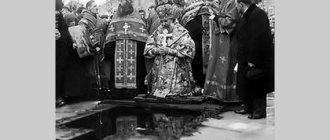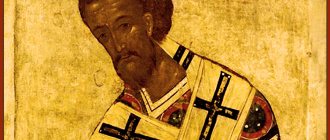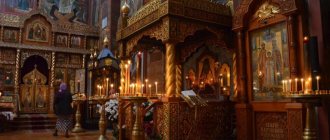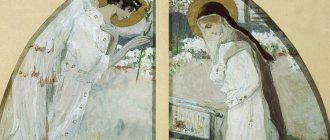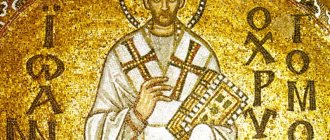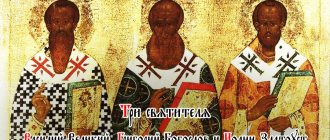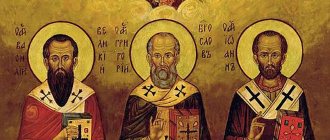The memory of St. John Chrysostom , Patriarch of Constantinople, is established annually on November 26 (November 13 according to the strict style) in honor of the anniversary of his accession to the archbishop's see. The holy fathers call Saint John Chrysostom “the mouth of Christ, the universal luminary, the universal teacher.” John Chrysostom was from Antioch. He studied with the best philosophers and rhetoricians. Since 398, John Chrysostom has been Archbishop of the Church of Constantinople. He was the greatest preacher and left us a great theological legacy. The works of John Chrysostom are recognized by researchers as the most important sources on the history of Antioch in the 4th century.
Priestly ministry of monk John and theological works
Saint John Chrysostom (Chrysostom), Archbishop of Constantinople, is one of the three Ecumenical Hierarchs. Born around 347 in Antioch , in the family of a military leader. His father, Secundus , died shortly after the birth of his son. John's mother, Anfisa , remained a widow at the age of twenty. She decided not to marry again, but to devote herself to raising her son in Christian piety. Young John studied with the best philosophers and rhetoricians of the time. One of his teachers was a representative of sophistry, the head of the rhetorical school in Antioch - Libanius (314-193). From an early age, John turned to the study of the Holy Scriptures and prayer. In 367, he received holy baptism from his mentor, Bishop of Antioch Meletius (d. 381). Three years later, John was ordained as a reader. In 372, Bishop Meletius was sent into exile by Emperor Valens (328-378). John, together with Theodore (c. 350-428; later Bishop of Mopsuestia), studied at the theological school of Antioch with presbyters Flavian and Diodorus of Tarsus.
When John's mother died, he took monastic vows. Soon John was considered worthy for the episcopal rank. However, he chose not to become a bishop. During this period John wrote his great work, Six Words on the Priesthood . He spent four years in the desert, where he created such works as “ Against those who take up arms against those seeking monasticism ” and “ Comparison of the Monk with the Tsar ” (“Comparison of the power, wealth and advantages of the king with the true and Christian wisdom of monastic life”), imbued with a high idea of dignity of monastic rank. For two and a half years he labored in silence while in a cave.
When John returned to Antioch, Bishop Meletius made him a deacon (381). John created such theological works as “ On Providence ” (“To Stagirius the Ascetic”), “ The Book of Virginity ”, “ To the Young Widow ” (two words), “ The Book of Saint Babylon and Against Julian and the Pagans ”. In 386, John was ordained a presbyter by Bishop Flavian of Antioch (320-404). Prester John became a brilliant preacher of the Word of God. For his gift of the God-inspired word, he received the name “ Chrysostom ” from the flock. For twelve years, twice a week, and sometimes daily, John preached in church to a large crowd of people. At this time, he wrote commentaries on a number of books of the Holy Scriptures and many conversations on individual biblical texts, as well as teachings on holidays, in praise of the saints and apologetic words (against the Anomeans, Judaizers and pagans). In addition, Prester John had concern for the poor: the Church of Antioch provided food daily for up to 3,000 virgins and widows, not counting prisoners, wanderers and the sick. At the beginning of Great Lent in 388, Prester John began an interpretation of the book of Genesis, which he completed at the end of October. During Lent, he delivered 32 discourses. During Holy Week he spoke about the traitor and about the Cross, during Easter Week and until Pentecost he preached daily sermons.
From Easter the following year, John began expounding the Gospel of John, and at the end of 389 he moved on to the Gospel of Matthew. In 391, the Christians of Antioch listened to his interpretation of the Epistles of the Holy Apostle Paul to the Romans and Corinthians. From 393 he turned to Galatians, Ephesians, Timothy, Titus and the Psalms. In a conversation on the Epistle to the Ephesians, John denounced the Antiochian schism: “I say and testify that to tear the Church apart means no less than to fall into heresy. The Church is the house of the Heavenly Father, One Body and One Spirit.”
Saint John Chrysostom - Archbishop of Constantinople
In 397, Archbishop Nektarios of Constantinople reposed. John was summoned from Antioch to be appointed to the see of Constantinople as archbishop. He began his archpastoral labors with the improvement of the priesthood. John donated the funds intended for the archbishop to maintain several hospitals and hotels for pilgrims. Archbishop John himself ate very sparingly and did not attend church feasts. He was involved in establishing Christianity not only in Constantinople, but also in Thrace, Asia Minor, and the Pontic region. John sent the most zealous Christian missionaries to preach in Phenicia and Persia. John wrote letters to Syria to restore the Marcionite Church, and achieved this. Preserving the unity of the Church, the saint did not allow the powerful Gothic military leader, who was dictating his terms to the emperor, to open an Arian temple in Constantinople. The saint put a lot of work into organizing a splendid Divine service: he composed the rite of the Liturgy, introduced antiphonal singing at the all-night vigil, and wrote several prayers for the rite of the blessing of oil.
What do they pray to John Chrysostom?
Saint John Chrysostom is considered the patron saint of people whose line of work involves communicating with other people. Prayers to John Chrysostom will help to gain confidence and correctly compose an important speech, for example, to lawyers, announcers, orators. It is also believed that St. John helps in learning, gaining wisdom and strengthening spirituality.
Prayer in front of the icon of John Chrysostom will protect you and your family from evil intentions, help you overcome poverty or get out of poverty and find prosperity.
Prayer to John Chrysostom
Lord, Jesus Christ, our God, open the ears and eyes of my heart, so that I, Lord, may listen to Your word, understand and do Your will, since “I am a stranger on earth; do not hide Your commandments from me. Open my eyes, and I will see the wonders of Your law.” My God, I hope in You to enlighten my heart.
Persecution of Archbishop John Chrysostom
Archbishop John denounced the licentiousness of the capital's morals, especially the imperial court. Empress Aelia Eudoxia (d. 404), wife of Emperor Flavius Arcadius (377-408), ordered the confiscation of the last property from the widow and children of the disgraced nobleman. Archbishop John interceded for the widow. But the empress did not yield and was angry with the archpastor. Her anger flared up even more when her ill-wishers told her that Archbishop John had her in mind in his teaching about vain women. The court, consisting of the hierarchs whom John had previously denounced, decided to deprive him of his rank and execute him for insulting the empress. But Emperor Arkady replaced the execution with exile. The people stood up for their archpastor. To avoid unrest, John himself gave himself into the hands of the authorities. That night a terrible earthquake occurred in Constantinople. Frightened Eudoxia asked her husband to return John from exile and sent him a letter begging for his return. But after a while, another denunciation awakens Eudoxia’s anger.
Saint John Chrysostom with his life. Icon of the mid-16th century. From the Fedorovsky Monastery of Pereslavl-Zalessky. PZIKHMZ
In March 404, an unrighteous Council was held, which decided to expel St. John. After the execution of the decree, the Church of Hagia Sophia and the Senate building burned down. Devastating barbarian raids soon followed. The slanderers fled to Alexandria. But after two months, a new denunciation awakens Eudoxia’s anger. And again in the capital’s church, the saint in a short speech blesses the Lord “for all His ways.” Eudoxia died in October 404. Even the pagans saw in these events heavenly punishment for the unrighteous condemnation of the saint of God.
Library of the Russian Faith Teachings in memory of St. John Chrysostom. Great Menaion of Cheti →
Read online in original
Description of the icon of the three saints
In Rus', the Three Saints icons appeared at the end of the 14th century. They are always depicted in full growth, in solemn church vestments. In the image of these holy elders, attention is drawn to their high foreheads, a sign of intelligence, learning and wisdom. In their left hand they hold the Holy Scriptures (in other versions - scrolls), the fingers of their right hand are folded for blessing.
All the details of the vestments are carefully written out, but they do not overshadow the significance of the faces: each of them is individual and marked by deep psychologism.
Repose of Archbishop John Chrysostom
John, while in Armenia, strengthened his spiritual children in the faith. His numerous letters to the bishops of Asia, Africa, and Europe have been preserved. In 405 John fell ill. But his ill-wishers continued to commit outrages. An order came from Constantinople to transfer John to Pithiunt (Abkhazia). John made the transition, which lasted three months in rain and heat, under escort, being weakened by illness. In Comana his strength left him. At the crypt of St. Basilisk, consoled by the appearance of the martyr (“Don’t be discouraged, brother John! Tomorrow we will be together”), having received the Holy Mysteries of Christ, John with the words “Glory to God for everything!” passed away to the Lord on September 14, 407.
John was buried in Comana Pontica.
In 438, his relics were transferred to Constantinople. According to legend, during this event the people shouted with one voice: “Accept your throne, father!”, and the lips of the saint, lying incorrupt in the tomb, opened, and he exclaimed “Peace to all!” During the Fourth Crusade (1204), the relics of St. John were taken from Constantinople to Rome, and on November 26, 2004, by decision of Pope John Paul II, they were returned to the Church of Constantinople along with the relics of Gregory the Theologian and are stored in the Cathedral of St. George in Phanar.
Transfer of the relics of St. John Chrysostom to Constantinople to the Church of the Holy Apostles. Miniature Minology of Vasily II. Constantinople. 985 Vatican Library. Rome
John Chrysostom is the author of the liturgy of the Byzantine rite, which, according to the Charter, is celebrated on most days of the liturgical year.
Veneration of St. John Chrysostom. Troparion, Kontakion and Canon
John Chrysostom is revered among the three “ ecumenical teachers ” (together with Basil the Great and Gregory the Theologian), the celebration in their honor takes place on February 12 (January 30, old style). Remembrance days are also celebrated:
February 9 (January 27, old style) - transfer of the relics of St. John Chrysostom (from Comana to Constantinople);
September 27 (September 14, old style) - repose of St. John;
November 26 (November 13, old style) is the day of St. John Chrysostom, Archbishop of Constantinople (the anniversary of his accession to the archbishop's see).
Troparion and Kontakion to St. John Chrysostom
Troparion, tone 8.
From your lips is like a radiant dawn, the grace given by God to you, enlightening the universe. Do not lay down the treasure of the world for money, but show us the height of humility of mind, and chastising Father John Chrysostom with your words, pray to the Word of Christ God, to save our souls.
Kontakion, tone 6.
We receive Divine grace from heaven, and with our lips teach all to worship the one God in the Trinity, John Chrysostom, the all-blessed reverend, we worthily praise you, for you are a mentor, as you are shameless.
Library of the Russian Faith Canon to St. John Chrysostom →
Read online
Library of the Russian Faith Canon for the Translation of the Relics of St. John Chrysostom →
Read online
Saint John Chrysostom - Ecumenical Teacher
“The life of the righteous is brilliant; but how does it become brilliant if not through patience? Having acquired it, love it, brother, like the mother of courage.”
St. John Chrysostom
February 9 - transfer of the relics of John Chrysostom from Comana to Constantinople. February 12 - Council of the Ecumenical Teachers and Saints Basil the Great, Gregory the Theologian and John Chrysostom. September 27 - repose of St. John Chrysostom. November 26 is the day of remembrance of the saint.
What do they pray for and what does John Chrysostom help with? The works and merits of St. John The Life of St. John Chrysostom Prayers to St. John Chrysostom Akathist to St. John Chrysostom The Greatness of St. John Chrysostom Video film about St. John Chrysostom
WHAT DO YOU PRAY TO THE SAINT FOR AND WHAT DOES JOHN CHRYSOSTOM HELP WITH?
Saint John Chrysostom is the patron saint of those people whose line of work involves communicating with other people. Prayers to him can help him develop correct, competent speech, for example: lawyers, announcers, orators. It is believed that Saint John helps in learning, gaining wisdom and strengthening spirituality. And the icon of John Chrysostom in the house will protect against evil intentions, help overcome poverty or get out of poverty and find prosperity.
It must be remembered that icons or saints do not “specialize” in any specific areas. It will be right when a person turns with faith in the power of God, and not in the power of this icon, this saint or prayer. Which saints and who should we pray to on different occasions and why our prayers remain unanswered.
WORKS AND MERIT OF ST. JOHN CHRYSOSTOM
The Holy Church reveres Saint John Chrysostom, along with Saints Basil the Great and Gregory the Theologian, as universal teachers who revealed to the world in detail the essence of Christian teaching. John Chrysostom teaches in detail, step by step, how to correctly interpret the Holy Scriptures, and not draw your own, sometimes erroneous, conclusions from it. He clearly and clearly expounds and explains the apostolic teachings and the writings of the earlier holy fathers.
The saint revealed to the world interpretations of the Holy Scriptures (the books of Genesis, the Psalter, the Gospels of Matthew and John, the Epistles of the Apostle Paul). John wrote explanations for a large number of texts of the Holy Bible, we learned the thoughts and teachings of the saint on holidays, his praise of the saints and his attitude towards those who distort Christianity. A huge number of books, letters and sermons of the teacher John have reached us.
THE LIFE OF JOHN CHRYSOSTOM
Saint John Chrysostom was born around 347 in the capital of ancient Syria, the city of Antioch, into the family of a military commander. This was the time when the persecution of Christians in the Roman Empire ended. Despite the early death of his father, the wealth of his family allowed St. John to receive an excellent education; his teachers were the best philosophers and orators of that time. As a young man, at the age of 18, he went to Athens to continue his further studies. Here Saint John began to study the Holy Scriptures in depth and, returning home at the age of 20, received baptism from the Bishop of Antioch.
Soon John was ordained as a reader, and after that he was offered to become a presbyter, but he refused. Why he made this decision we learn from his “Six Words on the Priesthood”:
“A shepherd needs to have a lot of prudence and many eyes in order to observe the state of the soul from all sides. How many become embittered and give in to despair of their salvation because they cannot endure cruel healing; so, on the contrary, there are those who, having not received punishment corresponding to their sins, indulge in carelessness, become much worse and decide to sin even more.”
Many newly baptized people then considered Christianity not a true faith, something different from paganism, but an ideology that was pleasing to the authorities. Therefore, real “ideological” Christians became monks. After the death of his mother, John gave away his fortune, became a monk, and for four whole years he went into solitude, two of which he was in complete silence.
In 381, Saint John returned home, where he finally accepted the priesthood, and five years later he became a presbyter. At that time there were no newspapers or radio, so the only way to educate the people was through sermons. The educated and intelligent priest very simply and, at the same time, talentedly preached to his flock, for which he received the name “Chrysostom.” The basis of John Chrysostom’s sermons was the Holy Scripture, he said about this:
“Countless disasters have arisen from ignorance of the Scriptures: hence the great infection of heresies, hence the careless life and useless labors. Just as those deprived of this light cannot walk straight, so those who do not look at the ray of divine Scripture are forced to sin much and often, since they truly walk in the deepest darkness.”
Saint John could explain in detail, sermon after sermon, some book from the Bible, or he could tell in a conversation how Scripture speaks about some upcoming holiday. All this happened vividly, not at all like other preachers did in their boring lectures. At the same time, he believed that Scripture clearly indicates how to live and fulfill God’s commandments.
But not only did John serve God with his eloquence; in Antioch he was also involved in real affairs: he took part in the construction of hospitals and charitable institutions. At the same time, his soul was not inclined to luxury, he wore ordinary clothes and was content with simple food. In 397, after the death of Archbishop Nektarios of Constantinople, John became hierarch of the capital. This appointment was facilitated by Emperor Arcadius himself, who greatly respected the gifted saint.
But the emperor's expectations were not met. Saint John turned out to be a real bishop, a servant of the will of God, and not an official favored by power who plays the music ordered by the ruling elite. John practically no longer preaches, but is engaged in administrative work. At the same time, regardless of rank and dignity, he eliminates unclean clergy and demands honesty and openness from others in their service. John fearlessly speaks out against social inequality:
“At first God did not make one rich and another poor and, having brought people, did not show one many treasures and deprive another of this acquisition, but provided everyone with the same land for cultivation. How is it that, when it is common property, you own so many and so many plots, while your neighbor does not have a single piece of land? The self-interested rich are some kind of robbers who sit down along the road, robbing passers-by and burying the property of others in their storerooms... like pigs in the mud, they delight in wallowing in the filth of the love of money.”
In the ruling priesthood there were also many dissatisfied with the reign of John Chrysostom, who considered his actions unnecessary and even cruel. In 403, by decision of the Council of Bishops, the saint was sent into exile. But he was soon returned from exile, thanks to the support of the people, who demanded the return of their beloved shepherd John back.
Many fall under the “press of truth” of the new archbishop, not excluding the emperor himself and his wife, whom John denounced for excessive luxury and greed towards his subordinates, and even just recently such talk in relation to the imperial family was considered a criminal offense. The emperor’s patience ran out after the archbishop reacted to the installation of a bust of the empress at the hippodrome: “Again Herodias is furious, again indignant, again dancing, again demanding the head of John on a platter.” He compared this desire to glorify himself with Herodias, and the emperor himself with Herod.
And again, in 404, the Council of Constantinople meets, the decision of which is to send John Chrysostom to a new exile. He writes about this:
“Brethren, a thief does not come where there is brushwood, hay and firewood, but where there is gold, or silver, or pearls; so the devil does not enter where there is an adulterer, or a blasphemer, or a predator, or a covetous person, but where those who lead a desert life... So, if they drive me out, I will become like Elijah; if thrown into the mud - Jeremiah; if at sea - to the prophet Jonah; if in the ditch - to Daniel; if stoned - Stefan; if beheaded - to John the Baptist; if they beat you with sticks - to Pavel; if they cut it with a saw - to Isaiah; and oh, if only with a wooden saw, that I might enjoy the love of the cross!”
Saint John Chrysostom was sent into exile to Armenia (the city of Kukuz), then to modern Pitsunda (Abkhazia), on the way to which he died in Comana on September 14 (old style) 407. Before his death, John Chrysostom summed up his earthly life with the words:
THANK GOD FOR EVERYTHING
Although the repose of St. John Chrysostom was on September 14, the day of his memory was moved to November 13 (26 New Style) so that it would not coincide with the Feast of the Exaltation of the Life-Giving Cross of the Lord. In addition to this date, January 27 (February 9, new style) commemorates the transfer of the holy relics of John Chrysostom from Comana to Constantinople, and January 30/February 12 - the Council of the Ecumenical Teachers and Saints Basil the Great, Gregory the Theologian and John Chrysostom.
GREATNESS
The Greatness of Saint John Chrysostom
We magnify you, O holy Father John, and honor your holy memory: for you pray for us, Christ our God.
VIDEO
Video about Saint John Chrysostom
Icon of the Mother of God Burning Bush
Share:
Saint John Chrysostom. Icons
The oldest surviving images of John Chrysostom are in the church of Santa Maria Antiqua in Rome (frescoes from the mid-7th and mid-88th centuries) and in the chapel at Khirbet el-Mard (7th century).
The iconography of St. John Chrysostom is almost no different from the general iconography of saints. But in Byzantine times it had one peculiarity: the saint was painted with a cross - a sign of martyrdom. But, as you know, the saint suffered not from pagans or heretics, but from his own brothers in faith. And this cross in the era of the Byzantine Empire was a reminder that martyrdom is possible not only in the era of persecution.
Saint John Chrysostom. Greece. XIV century, Vatopedi Monastery
Images of the saint became widespread in church art. In Russian icon-painting originals, the iconography of John Chrysostom is described as follows: “... the brada aka Cosmas the Unmercenary, a little oversize, sparse, hair on the head of the russian, a little curly, the forehead is high, wrinkled, the robe of the saint, sakkos cinnabar, in the crucis there are golden crosses, underside is green, by hand blesses, and in the other a book.”
Saint John Chrysostom. Mosaic of St. Sophia Cathedral in Kyiv (XI century)
Saint John is revered as the creator of the edition of the Liturgy, the most widespread in the Orthodox Church, and therefore his image can often be seen in the church in the Altar or in the iconostasis in the priestly rank along with other Fathers of the Church.
John Chrysostom. Last quarter of the 14th century. From the Deesis rank. Annunciation Cathedral of the Moscow Kremlin, Moscow
John Chrysostom. 1425–1427 Trinity Cathedral of the Holy Trinity Sergius Lavra, Sergiev Posad
Saints John Chrysostom and Basil the Great. First half of the 16th century. Vologda lands, fragments of the Royal Doors
|
|
Rules for praying before an icon
Prayer is sincere and confidential communication between the prayer book and the saint standing for him before Christ, and includes a certain request.
John Chrysostom. Shchigry Icon Gallery
But how to structure a “conversation” correctly so that Pleasant will listen to the request and help the person?
Here are the basic prayer rules that must be followed:
- prayer must be sincere, there should not be a drop of lies or fiction in it;
- it is forbidden to be distracted by extraneous sounds and conversations, a person must be focused;
- you must think about the saint for whom they are praying, and about those people for whom the petition was raised;
- a prayer hastily pronounced from memorized words, without feeling, will not please the saint, will upset him and will not bring any benefit;
- you cannot ask for great material wealth and something that can harm a brother in Christ;
- before starting prayer, it is advisable to ask the priest for blessings for reading prayers, confessing sins and receiving communion;
- the prayer request must be said repeatedly and for a long time; it is possible that the saint will fulfill the request within a few days, or it may take several years to wait for the requested fulfillment - therefore, one must not lose faith and the Lord, through the prayers of the saint, will certainly reward the prayer book for his work, patience and faith.
Prayer in church is considered stronger than at home, because the temple is the House of God, it is here that the Lord is invisibly present. Here the prayer of the prayer book is combined with fiery faith and requests of other parishioners, which makes them more spiritual and purer.
Advice! You can come to the temple and read a prayer to the saint at any time when the temple is open, but it is best to do this during the service.
Temples in the name of St. John Chrysostom
One of the oldest monasteries in Moscow , located on Bolshoy Zlatoustinsky Lane, was consecrated in the name of John Chrysostom The first mention of the monastery dates back to 1412. During the Soviet period, the monastery was destroyed.
View of the Chrysostom Monastery, 1882
was built in Kostroma . The first mention of it dates back to 1628. At the beginning of the 17th century, on this site there was an ensemble of two wooden churches - a “winter” one in the name of the holy martyrs Florus and Laurus and a “summer” one in the name of St. John Chrysostom. In the 17th century, the wooden church of St. John Chrysostom was rebuilt, and in the middle of the 18th century a stone church was built in its place.
Church in the name of St. John Chrysostom in Kostroma
was consecrated in the name of John Chrysostom . According to the Klirovy Gazette, the temple was built in the 17th century. The church is two-story, i.e. consists of two rooms: the lower and upper churches. The throne of the upper church was consecrated in the name of John Chrysostom, the throne of the lower church - in the name of the Holy Myrrh-Bearing Women.
Temple in the name of John Chrysostom in Vologda
A chapel in the Kidron Valley (Judean Desert) of Israel was consecrated in the name of John Chrysostom . The chapel itself was apparently converted from the residential cell it was originally.
Chapel in the name of John Chrysostom in the Judean Desert
John the Theologian:
Memorial Day (according to modern times): 21.05, 9.10.
One of the 12 apostles, the youngest of them, in the world bore the name John Zebedee. The Lord valued him for his sincere sacrifice and purity of thoughts. He owns the words “God is love.”
John the Evangelist followed Jesus as a teenager and remained devoted to him all his life. He took care of the Mother of God until her Dormition and compiled the New Testament.
In some scenes of the icons he is depicted with his disciple Prokhor, in others - with an enlightening angel. His image is present on life-descriptive icons telling about the Last Supper, the Crucifixion and other episodes.
They pray to John the Theologian for the joy of family life, for health and spiritual wealth. Women often turn to him with prayers for motherhood.
